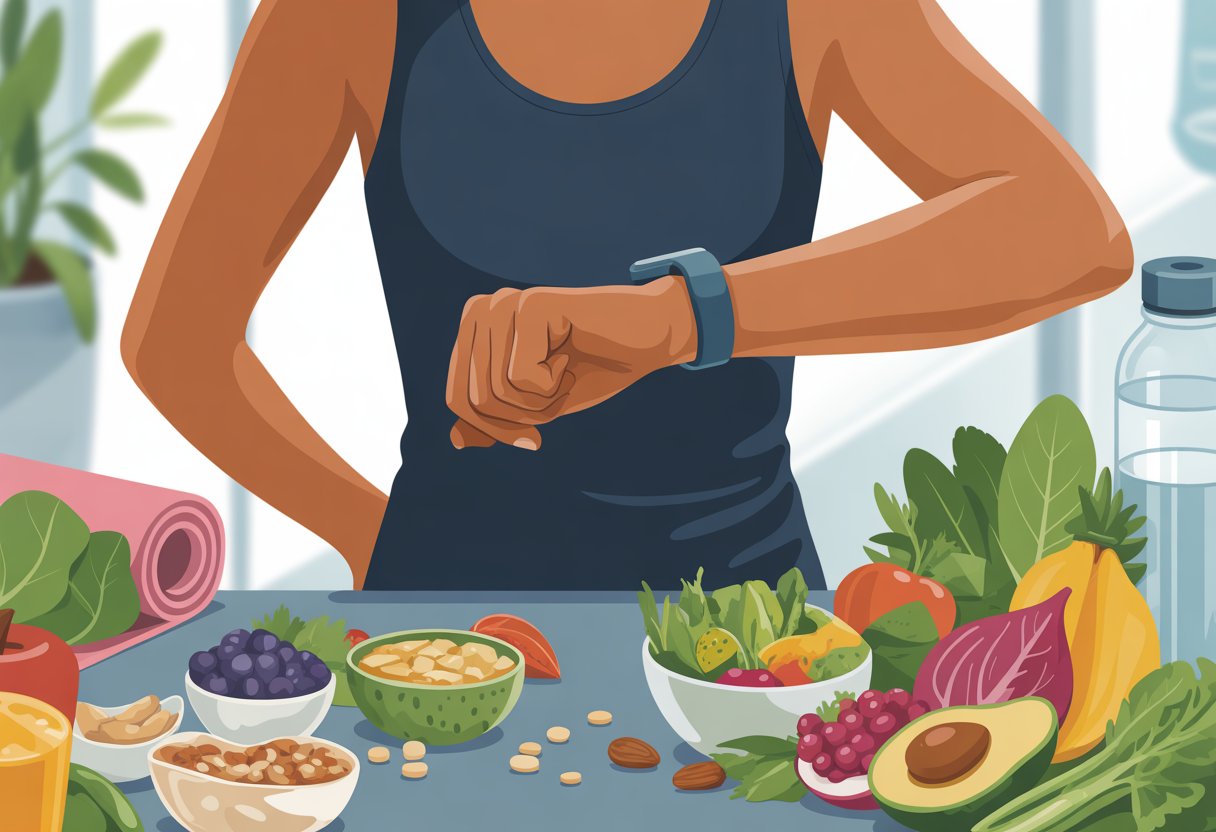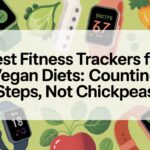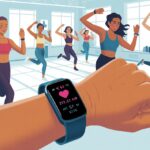So, we’ve all decided to be plant-powered superheroes, but honestly, sometimes it feels like you need a degree just to figure out what you’re eating. Vegan diets can get confusing—are we getting enough protein, or just living off peanut butter and a sense of moral high ground? Using a fitness tracker built for vegan diets helps us keep tabs on calories, protein, vitamins, and everything else—without turning every meal into a math problem.

Let’s be honest, nobody wants to spend hours figuring out if their lunch had enough B12 or magnesium. Fitness trackers designed for vegans make things way simpler.
We can log meals, set goals, and even track water intake so we don’t end up living on caffeine and kale.
If we want to avoid becoming junk food vegans or missing out on key nutrients, learning how to use these trackers is the move. It’s like having a tiny, judgment-free coach in your pocket, cheering every time you remember to eat a chickpea.
Understanding Fitness Trackers And Vegan Diets
Bringing a fitness tracker into our vegan routine isn’t just about counting steps or flexing our 7,000-step dance moves. It helps us keep an eye on nutrition, health stats, and how our plant-based power stacks up with our workout plans.
Key Benefits Of Using A Fitness Tracker For Vegans
Fitness trackers really can save the day, sometimes literally. They help us stick to our health goals, and not just nod at tofu like it’s a life coach.
With trackers, we keep an eye on calories, protein, and vitamins like it’s our job.
Since vegan diets can sometimes run low on things like B12 or iron, tracking what we eat keeps us on track. Some trackers let us monitor macronutrients, so we’re more likely to hit daily targets and less likely to live on vegan cookies.
Many fitness apps let us log meals and see how our plant-based diet affects muscle gain and energy. This is huge for checking if our workout plan matches our nutrition.
And honestly, it helps when family asks, “But where do you get your protein?”
Popular Fitness Tracker Apps And Devices
There are so many fitness apps and trackers out there, it’s almost overwhelming. Smartwatches like Fitbit, Apple Watch, and Garmin track steps, calories, sleep, and heart rate—pretty much everything except our secret love for vegan ice cream.
Apps like MyNetDiary or Plantevo focus on nutrition and are great for vegans. We can track calories, protein, water, and more.
Some apps let us log food by scanning barcodes or searching huge vegan food databases. That saves time for more important debates, like whether oat milk or almond milk froths better.
How Vegan Diets Impact Health Metrics
A vegan or plant-based diet usually means more fiber, antioxidants, and vitamins, and less saturated fat. Tracking how our diet changes our bodies can show some real benefits.
Studies link plant-based eating to lower risks for heart attack and stroke, so those stats on our tracker might give us something to brag about at the next potluck.
Fitness trackers show how our diet impacts energy, sleep, weight, and hydration. When we log meals, we can actually see how what we eat affects our workouts.
All our data in one place means we can finally back up our claims when someone says, “But vegans can’t build muscle!” Stats don’t lie—and maybe we’ll flex a bit, just for science.
Setting Up Your Fitness Tracker For Vegan Nutrition
Getting our fitness tracker ready for a vegan diet isn’t rocket science, but it does take a little effort. We need to make sure our nutrition goals fit our plant-based lifestyle, keep an eye on macronutrients, and track calories with laser focus.
Customizing Nutrition Goals On Your Device
First, let’s make our tracker speak vegan. In most apps, like MyNetDiary or SnapCalorie, we set up our nutrition profile by choosing dietary preferences—yes, actually check the vegan or plant-based box.
This helps our tracker suggest foods that won’t make us say, “Wait, is there cheese in this?”
We enter details like age, gender, weight, height, and activity level so the tracker knows what we’re actually doing—not just assuming we’re marathoners living on air.
Next, we set custom nutrition goals. It’s smart to pick protein, carb, and fat targets based on plant foods we actually like, like tofu, beans, and nuts.
Don’t forget micronutrients! Vegan diets sometimes miss vitamin B12, iron, and calcium, so if our tracker allows, we add those to our dashboard for bonus health points.
If you want more details, check the steps in this vegan nutrition tracker guide.
Tracking Macronutrients: Protein, Carbs, And Fats
Carbs? Easy for vegans—pasta is always calling. Protein can be trickier, so we make protein tracking a top priority on our app.
We enter foods like lentils, quinoa, and seitan, and the app does the number crunching for us.
Carbs and fats get tracked too, since plant-based diets can lean heavy on grains or nuts if we’re not careful. Apps like MyNetDiary show the data in colorful charts, which somehow makes us feel more organized than we probably are.
It helps to log meals as we eat them, not just at the end of the day. Forgetting that hummus wrap can turn into a mystery about missing calories.
Monitoring Daily Caloric Intake
Calories still matter, even if we pretend kale smoothies have magical powers. We need to enter every snack, meal, and smoothie into our tracker—apps like Plantevo and SnapCalorie make this pretty painless.
The tracker adds up our calories and shows if we’re on target for weight goals. We can check tables or pie charts to see which foods are heavy hitters.
A sample calorie log might look like this:
| Meal | Calories |
|---|---|
| Breakfast | 350 |
| Lunch | 600 |
| Snack | 200 |
| Dinner | 550 |
By tracking daily, we avoid those “how did I eat that much almond butter?” moments at the end of the week.
Logging Essential Nutrients Without Animal Products
Making sure we get all the right nutrients on a vegan diet can feel like a full-time job. Luckily, a fitness tracker helps us monitor what our bodies actually need—no chasing chickens or milking almonds required.
Iron And Calcium Tracking—Yes, You Actually Need Them
Iron isn’t just for bodybuilders or cereal boxes. On a vegan diet, we skip red meat but still need iron for healthy blood.
Our fitness trackers let us log lentils, tofu, and spinach—top plant sources of iron—and warn us if we’re skimping. Pairing these foods with vitamin C (like peppers or oranges) helps our bodies absorb more iron.
Calcium might be tied to dairy in most people’s minds, but our bones don’t care if we’re cheese-free. Instead, we look for calcium-fortified plant milks, broccoli, almonds, and tahini.
Our food logging app will show us if we’re consistently low so we can fix it before our teeth start protesting. For more ideas, this list of vegan iron and calcium sources is worth a peek.
Table: Top Vegan Iron and Calcium Sources
| Nutrient | Foods | Serving Size Example |
|---|---|---|
| Iron | Lentils, tofu, pumpkin seeds | 1 cup cooked lentils |
| Calcium | Fortified soy milk, bok choy, almonds | 1 cup soy milk, 1 cup bok choy |
Vitamins, Minerals, And Heroic Antioxidants
Vitamin B12 is tough to find without animal products, so we track fortified cereals or B12 supplements. We also watch for vitamin D (hello, sun and fortified plant milks), zinc (chickpeas, beans), and iodine (seaweed).
Mineral intake can slip if we get stuck on pasta and vegan cookies. Logging daily meals helps us spot if magnesium or potassium are falling behind.
Antioxidants—found in berries, leafy greens, and nuts—give our bodies a little extra armor. Fitness trackers with barcode scanning make logging these foods almost fun. Almost.
Identifying Gaps In Your Diet
Let’s be real: even with the best plans, sometimes we forget to eat greens and end up with a banana for dinner. Our fitness tracker makes charts and nutrient breakdowns that show where we’re doing well and where we need to step it up.
If our iron, calcium, or vitamin bars keep falling short, it’s time to rethink the grocery list. Many nutrition apps let us set reminders or offer meal suggestions.
For more ways to use tech for a balanced vegan diet, check out these tips for balanced vegan nutrition.
Daily tracking keeps us honest—and helps us avoid “accidentally” living off fries and vegan donuts.
Optimizing Workouts For Vegans Using Fitness Trackers
Fitness trackers are more than just fancy step counters—they’re our secret weapon for keeping vegan fitness on track. With the right settings and a bit of know-how, we can tune our plant-powered efforts and stay on top of recovery, energy, and nutrition without breaking a (soy-based) sweat.
Building A Balanced Plant-Based Workout Plan
Let’s be honest: nobody wants tofu arms or broccoli legs. Fitness trackers give us hard numbers on steps, active minutes, heart rate, and calories burned, which helps us build a workout plan that fits our plant-based lifestyle.
We can track cardio, strength, and flexibility days to make sure we hit all the muscle groups—not just our jaw from chewing kale.
By logging workouts and setting realistic goals, we dodge classic vegan workout mistakes like not eating enough or just doing endless cardio.
Many trackers sync with apps focused on plant-based strength training to help us plan balanced workouts that build muscle and avoid burnout.
We can also set reminders to stretch (fiber-rich hamstrings, anyone?) and take breaks.
No more skipping leg day, and no more expecting chickpeas to carry us through sprints.
Monitoring Recovery, Energy, And Fatigue
Missing sleep because we were Googling “hemp protein pancakes” again? Our tracker knows. Good fitness trackers record details like sleep quality, resting heart rate, and daily movement.
These numbers help us spot fatigue early, so we don’t try to crush a HIIT session when we can barely finish our smoothie.
Recovery matters for anyone pushing themselves on plant fuel. Too much fiber can sometimes leave us feeling sluggish, so we track daily energy levels and recovery time after workouts.
If our tracker says we’re dragging, that’s a hint to rest, eat, or maybe stop arguing about oat milk online.
Custom alerts remind us to hydrate or wind down for bed. Our tracker is basically our vegan mom—just digital.
Combining Nutritional Data With Activity Metrics
Fitness trackers really shine when we throw nutrition data into the mix. Plenty of apps let us link our food logs to our trackers, so we can actually see calories in versus calories out.
That matters for vegans, since plant-based foods often bring lots of fiber and volume but not always as much protein or calories as we think. Sometimes, what looks like a mountain of salad turns out to be pretty light on fuel.
To get the best results, we track protein, iron, and vitamin B12. That way, our macros actually support our workouts and recovery.
Apps like Calorie Counter by NutriSnap let us log meals and nutrients. We’ll know if we’re thriving or just running on empty after leg day.
When we combine this info with our activity stats, we can make smarter tweaks. If our tracker says we torched a record number of calories but our food log is all salad and air, it’s time to slap together a peanut butter sandwich—or maybe two.
Vegan Food Logging: From Quinoa To Legumes
Getting vegan nutrition right can feel like herding cats. Tracking plant foods helps us dodge the “just eat more salad” trap.
We need fiber, protein, and healthy fats, not just leafy greens. Our fitness tracker can help make sure nothing slips through the cracks.
Tracking Whole Grains And Nutrient-Dense Foods
If we’re tired of explaining that quinoa isn’t just fancy rice, our tracker’s got our back. We can start by logging whole grains like quinoa, brown rice, oats, and barley.
Quinoa is a multitasker—loaded with protein, iron, and fiber. It takes maybe two minutes to add it to most apps, and honestly, it’s a chance to brag about our good taste.
For more variety and a better nutrient spread, we can mix in other grains.
| Whole Grain | Fiber (per cup, cooked) | Protein (per cup, cooked) |
|---|---|---|
| Quinoa | 5g | 8g |
| Brown Rice | 3.5g | 5g |
| Oats | 4g | 6g |
| Barley | 6g | 4g |
Most trackers let us scan barcodes or just search for foods, so logging our daily bowl of oats is almost as easy as eating it. Need ideas? Apps like SnapCalorie let us save favorite meals, which is perfect when we’re deep in a “grain bowl phase.”
Logging Legumes, Nuts, And Seeds (And Not Getting Bored)
When we log chickpeas, lentils, and black beans, we might start wondering just how many types of beans exist. Should we try them all? Maybe.
Legumes are vegan superheroes. They pack in fiber and give us those essential amino acids.
While tracking, we focus on serving sizes. A cup of cooked lentils brings about 15 grams of fiber and 18 grams of protein.
Apps like Cronometer break these numbers down for us, so we don’t have to guess if that giant bean stew was a power move or a fiber overload.
To mix up flavors, we toss in nuts and seeds—almonds, walnuts, flax, chia, whatever’s handy. Most trackers let us log combos and snacks together, so we don’t have to mourn those three stray almonds.
Rotating our beans and seeds keeps things interesting and covers more nutrients. It’s a sneaky way to dodge food boredom.
Our food log proves we don’t just eat carrots (though, yeah, we still eat a lot of carrots).
Using Data For Vegan Weight Loss Or Maintenance
Tracking what we eat with a fitness tracker gives us real numbers for calories, protein, carbs, and fats. This keeps us honest about tofu overloads or those surprise cookie binges.
Managing Calories While Staying Satisfied
When we start using a food tracker, we realize pretty fast how quickly cashew butters and fancy plant milks add up. A digital log helps us spot where sneaky calories hide, and keeps us honest about those second breakfasts.
Apps like SnapCalorie’s tracker let us pick “vegan” as a setting, so we don’t suddenly get suggestions for chicken wings or cheese.
Fiber-rich foods—beans, lentils, whole grains—fill us up with fewer calories. They also boost our protein, which helps us keep muscle if we’re losing weight.
We can even set alerts in the tracker to warn us before we wander into rice cake binge territory.
Eating whole, minimally processed foods means we can eat bigger portions for the same calories. That’s some math we can actually get behind.
Interpreting Progress Reports And Adjusting Goals
Every week, our tracker spits out progress reports. Sometimes we feel like we’re crushing it, but the data says our protein goal is still lagging.
Or maybe the tracker shows we’re cutting calories faster than we thought—no wonder our jeans suddenly feel loose.
These reports aren’t just numbers. They help us spot trends, like, “Why is Tuesday always oat milk latte day?”
If the scale isn’t moving, it’s a sign to tweak our calorie budget or add more protein from tofu or seitan.
We can use trend graphs to see if we’re consistent or just living for cheat days. If results stall, we adjust our calories based on how our bodies respond.
Honestly, it saves us from blaming the scale when the real culprit is another serving of nut butter.
Tips, Troubleshooting, And Next-Level Tracker Wisdom
Some days we’re on top of our vegan tracking game, and other days we’re just guessing how many chickpeas we inhaled. Let’s get real about what trips us up, pick our best tracking combos, and actually use our data for gains—not just guilt.
Common Vegan Tracker Mistakes To Avoid
Even the most dedicated among us mess up sometimes. One classic mistake: forgetting to track snacks or sauces.
It’s so easy to pretend that spoonful of peanut butter “didn’t count.” Spoiler: it totally did.
Another trap is picking tracker entries that match what we wish our meal was. Calling a loaded vegan burrito a “side salad” just to justify dessert? We’ve all been there.
We sometimes neglect certain nutrients. If we only focus on calories and protein, we might miss fiber, B12, or omega-3s.
Doing a quick check of our micronutrients once or twice a week helps. App reminders can save us here.
Instead of guessing portions (“That tofu block looked like 100 grams, right?”), we should actually weigh or measure key items, at least until we get a feel for it. Our macros will thank us.
Integrating Data From Multiple Apps
Most of us use more than one app—one for calories, one for steps, and maybe another for sleep. It can get messy.
Many fitness trackers sync with nutrition apps (like MyFitnessPal, Cronometer, or NutriSnap), but syncing sometimes goes sideways.
The trick is to pick a “home base” app—the one that fits our needs best—and keep most of our data there.
Keep app permissions updated and actually check those sync logs, so our calories burned don’t vanish into the cloud.
For the overachievers, setting up manual entries once a week can keep our numbers right when tech decides to take a nap.
Using Fitness Tracker Insights For Long-Term Success
Our trackers shouldn’t just nag us about yesterday’s step count. They’re actually pretty good at spotting patterns—sometimes helpful, sometimes, well, not so much.
Ever notice your energy drops on Mondays? Maybe that’s when you skimp on protein or just don’t sleep enough.
I like to check out trend reports from my tracker to see if I’m improving or just stuck in a rut. If that chart looks like a rollercoaster, maybe it’s time to shake up the meal prep or rethink the diet.
Setting the right goals really does make a difference. I’d recommend playing with tracker features that let you set reminders, tweak your targets, or even celebrate tofu wins with a goofy animation.
When motivation dips (because it will), I’ll throw on a podcast like No-Bullsh!t Vegan for a boost. High fives for us—and for our plant-based macros, too!
- Why is my fitness tracker not pairing with Apple Health? Troubleshooting for Technologically Cursed Mortals - December 22, 2025
- Why is my fitness tracker not updating firmware? Tech Tantrums and Update Woes Explained - December 21, 2025
- Why is the Sound Quality on My Bluetooth Headphones Poor? It’s Not Just Bad Music Taste! - December 21, 2025






